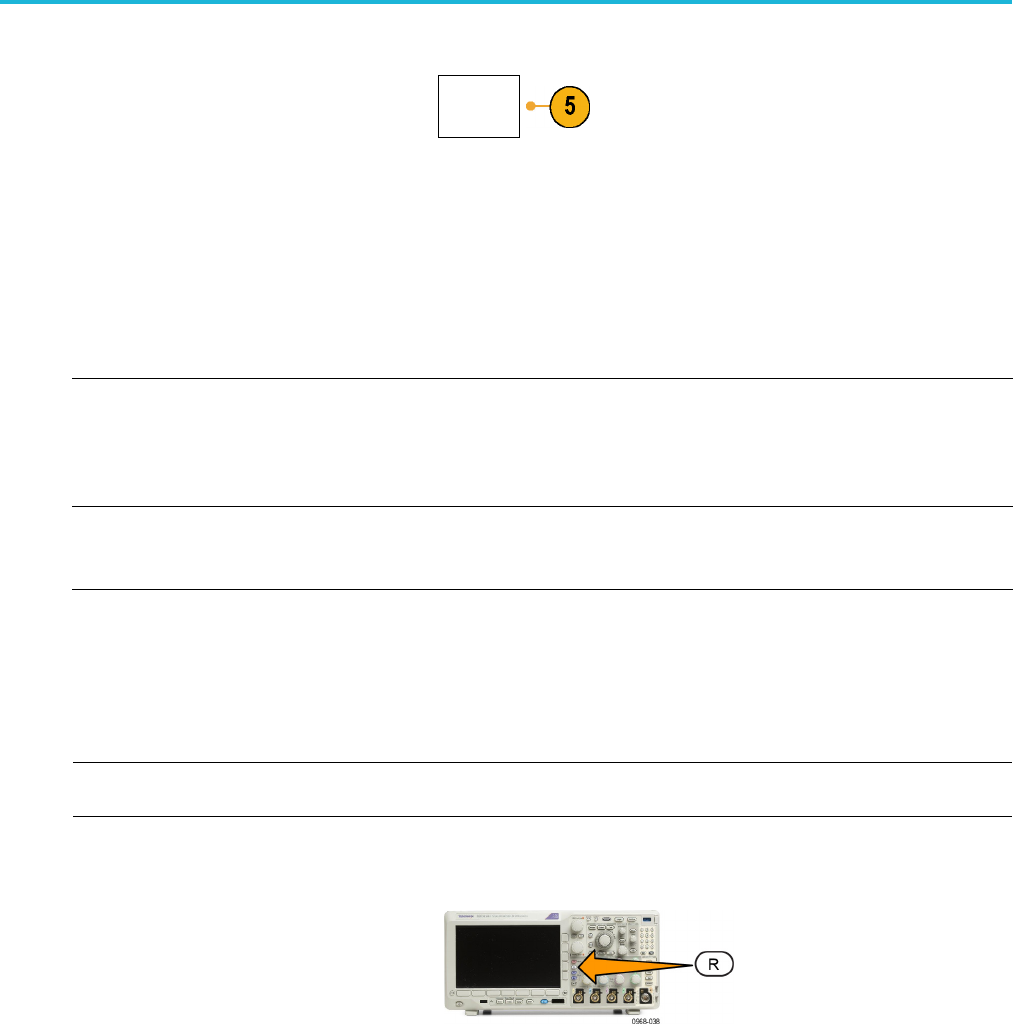User Manual
Table Of Contents
- toc
- Important safety information
- Compliance information
- Preface
- Installation
- Before Installation
- Operating Considerations
- Connecting Probes
- Securing the Oscilloscope
- Powering on the Oscilloscope
- Powering off the Oscilloscope
- Functional Check
- Compensating a TPP0250, TPP0500B or TPP1000 Passive Voltage Prob
- Compensating a non-TPP0250, non-TPP0500B or non-TPP1000 Passive
- Application Module Free Trial
- Installing an Application Module
- Upgrading Bandwidth
- Changing the Language of the User Interface or Keyboard
- Changing the Date and Time
- Signal Path Compensation
- Upgrading Firmware
- Connecting Your Oscilloscope to a Computer
- Connecting a USB Keyboard to Your Oscilloscope
- Get Acquainted with the Instrument
- Acquire the Signal
- Setting Up Analog Channels
- Using the Default Setup
- Using Autoset
- Acquisition Concepts
- Using FastAcq
- How the Analog Acquisition Modes Work
- Changing the Acquisition Mode, Record Length, and Delay Time
- Using Roll Mode
- Act on Event
- Setting Up a Serial or Parallel Bus
- Setting Up Digital Channels
- When and Why to Turn On MagniVu
- Using MagniVu
- Setting Up the RF Inputs
- Trigger Setup
- Display Waveform or Trace Data
- Adding and Removing a Waveform
- Setting the Display Style and Persistence
- Setting Waveform Intensity
- Scaling and Positioning a Waveform
- Setting Input Parameters
- Positioning and Labeling Bus Signals
- Positioning, Scaling, and Grouping Digital Channels
- Viewing Digital Channels
- Annotating the Screen
- Viewing the Trigger Frequency
- Displaying the Frequency Domain Menu
- Analyze Waveform or Trace Data
- Using Markers in the Frequency Domain
- Taking Automatic Measurements in the Time Domain
- Selecting Automatic Measurements in the Time Domain
- Customizing an Automatic Measurement in the Time Domain
- Taking Automatic Measurements in the Frequency Domain
- Taking Digital Voltmeter Measurements
- Taking Manual Measurements with Cursors
- Setting Up a Histogram
- Using Math Waveforms
- Using FFT
- Using Advanced Math
- Using Spectrum Math
- Using Reference Waveforms and Traces
- Using Wave Inspector to Manage Long Record Length Waveforms
- Auto-magnify
- Limit and Mask Testing
- Making Video Tests
- Making Automated Power Measurements
- Save and Recall Information
- Use the Arbitrary Function Generator
- Use the Application Modules
- Appendix A: Warranted Specifications
- Appendix B: TPP0250, TPP0500B and TPP1000: 250€MHz, 500€MHz and
- Appendix C: P6316 General-Purpose Logic Probe Information
- Appendix D: OpenSSL License

Save and Recall I
nformation
5. Push File Details to save to a USB or
network drive.
File Details
This brings up the file manager screen. Use
it to navigate to the desired drive and folder,
and optional
ly to specify the file name.
Skip this step to use the default name and
location.
Saving a wav
eform to file.
When you push File Details on the side menu, the oscilloscope changes the side menu contents.
The following table describes these side menu items for saving data to a mass storage file.
Side m e nu button
Description
Instrument SpecificFile
Format (.I
SF)
Sets the oscilloscope to save data from analog, digital, or RF channels (and math and
reference
waveforms derived, where possible, from those channels), in Instrument Specific
Format (.isf) format. This format is the fastest to write. It also creates the smallest-sized file.
Use this format if you intend to recall an analog waveform or RF trace to reference memory
for viewi
ng or measuring.
Spreads
heet file format
(.csv)
Sets the
oscilloscope to save data as a comma-separated data file that is compatible with
popular spreadsheet programs.
Analog and RF data stored in this file format can also be recalled to reference memory.
Saving a waveform or trace to reference memory. To save a waveform or trace to nonvolatile memory inside the
oscilloscope, push the Save Waveform screen button, select the waveform that you want to save, and then select one of
the reference w aveform locations.
Saved waveforms contain only the most recent acquisition. Gray-scale information, if any, is not saved.
NOTE. 10 M reference waveforms are volatile and not saved when the oscilloscope power is turned off. To keep these
waveforms, save them to external storage.
Displaying a reference waveform. To display a waveform stored in nonvolatile memory:
1. Push Ref R.
MDO3000 Series Oscilloscopes User Manual 167










